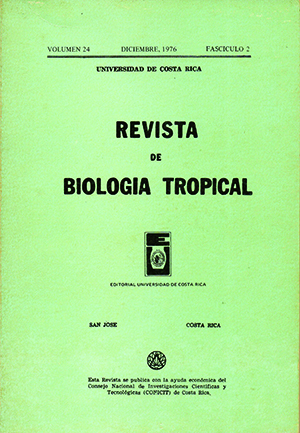Abstract
Numerieal abundance, biomass, and species diversity were determined for the benthic invertebrate communities of Golfo Dulce, an anoxic basin on the west coast of Costa Rica. Both abundance and biomass were less than that expected in a tropical environment. The polychaete Paraonis lyra dominated the community within the basin. It is suggested that a life history which includes pelagic larvae allows this species to domina te the benthic assemblage in regions of variable oxygen concentrations.References
Frankenberg, D., & R. J. Menzies 1968. Some quantitavie analyses of deep-sea benthos off Peru. Deep-Sea Res., 15: 623-626.
Gallardo, Ariel 1963. Notas sobre la densidad de la fauna bentónica en el sublitoral del norte de Chile. Gayana Zool., 10: 3-15.
Milis, Eric. L. 1969. The community concept in marine zoology, with comments on continua and instability in some marine communities; a review. J. Fish. Res. Bd. Canada, 26: 1415-1428.
Nichols-Driscoll, J. 1976. The effect of stable dissolved-oxygen stress on marine benthic invertebrate community diversity. Inter. Rev. der ges. Hydrobiol., (in press).
Odum, E. P. 1959. Fundamen tals of Ecology. 2d ed. W. B Saunders Company. Philadelphia. p. 145.
Pettibone, M. 1963. Marine Polychaete worms of the New England Region. Smithsonian Institution Bull. 227, part 1. 354 pp.
Pianka, Eric R. 1971. On r- and K-selection. Amer. Nat., 104 : 592-597.
Riehards, F. A., J. J. Anderson, & J. D. Cline 1971. Chemical and physical observations in Golfo Dulce, an anoxic basin on the Pacific coast of Costa Rica. Limnol. Oceanogr., 16: 43-50.
Sanders, H. L. 1968. Marine benthic diversity: a comparative study. Amer. Nat., 102 : 243-282.
Shannon, C. E., & W. Weaver 196 3. The Mathematical Theory of Communication. Urbana, Univ. of I11. Press. 125 pp.
##plugins.facebook.comentarios##

This work is licensed under a Creative Commons Attribution 4.0 International License.
Copyright (c) 1976 Revista de Biología Tropical


